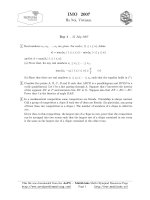Microprocessor final ver1 part7 2007
Bạn đang xem bản rút gọn của tài liệu. Xem và tải ngay bản đầy đủ của tài liệu tại đây (3.58 MB, 121 trang )
1
© DHBK 2005
N i dung môn h cộ ọ
N i dung môn h cộ ọ
1. Giới thiệu chung về hệ vi xử lý
2. Bộ vi xử lý Intel 8088/8086
3. Lập trình hợp ngữ cho 8086
4. Tổ chức vào ra dữ liệu
5. Ngắt và xử lý ngắt
6. Truy cập bộ nhớ trực tiếp DMA
7. Các bộ vi xử lý trên thực tế
2
© DHBK 2005
Ch ng 7: Các b vi x lý trên th c tươ ộ ử ự ế
Ch ng 7: Các b vi x lý trên th c tươ ộ ử ự ế
7.1 General purpose microprocessors
7.1.1 Intel 80x86
7.1.2 Xu hướng phát triển
7.2 Microcontrollers
7.2.1 Vi điều khiển của Microchip và Motorola
7.2.2 Họ vi điều khiển 8051
7.2.3 Họ vi điều khiển AVR
7.2.4 PSOC
7.2.5 Xu hướng phát triển
7.3 Digital signal processors
7.3.1 Texas Instruments
7.3.2 Motorola
7.3.3 Philips
7.3.4 Xu hướng phát triển
3
© DHBK 2005
Ch ng 7: Các b vi x lý trên th c tươ ộ ử ự ế
Ch ng 7: Các b vi x lý trên th c tươ ộ ử ự ế
7.1 General purpose microprocessors
7.1.1 Intel 80x86
7.1.2 Xu hướng phát triển
7.2 Microcontrollers
7.2.1 Vi điều khiển của Microchip và Motorola
7.2.2 Họ vi điều khiển 8051
7.2.3 Họ vi điều khiển AVR
7.2.4 PSOC
7.2.5 Xu hướng phát triển
7.3 Digital signal processors
7.3.1 Texas Instruments
7.3.2 Motorola
7.3.3 Philips
7.3.4 Xu hướng phát triển
4
© DHBK 2005
7.1.1 Vi xử lý của Intel
7.1.1 Vi xử lý của Intel
Nguồn Intel
5
© DHBK 2005
7.1.1 Vi xử lý của Intel
7.1.1 Vi xử lý của Intel
Nguồn Intel
6
© DHBK 2005
7.1.1 Vi xử lý của Intel
7.1.1 Vi xử lý của Intel
Nguồn Intel
7
© DHBK 2005
7.1.1 Vi xử lý của Intel
7.1.1 Vi xử lý của Intel
Nguồn Intel
8
© DHBK 2005
7.1.1
7.1.1
Intel 4004
Intel 4004
•
First microprocessor
(1971)
•
4-bit processor
•
2300 Transistors (P-
MOS), 10 µm
•
0.06 MIPS, 108 KHz, 640
bytes addressable
memory
•
-15V power supply
9
© DHBK 2005
7.1.1
7.1.1
Intel 8008
Intel 8008
•
First 8-bit processor (1972)
• Cost $500; at this time, a 4-
bit processor costed $50
• Complete system had 2
Kbyte RAM
•
200 KHz clock frequency, 10
µm, 3500 TOR, 0.06 MIPS,
16 Kbyte addressable
memory
•
18 pin package, multiplexed
address and data bus
10
© DHBK 2005
7.1.1
7.1.1
Intel 8080
Intel 8080
•
Second gen. 8-bit
processor, introduced
in 1974
•
40 pin package,
NMOS, 500K
instructions/s, 6 µm, 2
MHz, ±5V & +12V
power supply, 6
KTOR, 0.64 MIPS
•
64 Kbyte address
space (“as large as
designers want”, EDN
1974)
11
© DHBK 2005
7.1.1
7.1.1
Intel 8088
Intel 8088
•
16-bit processor
•
introduced in 1979
•
3 µm, 5 a 8 MHz, 29
KTOR, 0.33 a 0.66 MIPS,
1 Mbyte addressable
memory
12
© DHBK 2005
7.1.1
7.1.1
Intel 8086
Intel 8086
•
Introduced: 1978
•
Clock frequency: 8 - 10 MHz
16 bit integer CPU
address
data
16
20
13
© DHBK 2005
7.1.1
7.1.1
Intel 80286
Intel 80286
•
Introduced: 1983
•
1.5 µm, 134 KTOR, 0.9 to 2.6 MIPS
•
Clock frequency: 6 - 25 MHz
16 bit integer CPU
address
data
16
24
MMU
14
© DHBK 2005
7.1.1
7.1.1
Intel 80386sx
Intel 80386sx
•
Introduced: 1986
•
1 µm, 275 KTOR, 16 to 33 MHz, 5 to 11 MIPS
•
Clock frequency: 16 - 25 MHz
•
Software support and hardware protection for multitasking
32 bit integer CPU
address
data
16
24
MMU
15
© DHBK 2005
7.1.1
7.1.1
Intel 80386dx
Intel 80386dx
•
Introduced: 1988
•
Clock frequency: 16 - 40 MHz
•
Software support and hardware protection for multitasking
32 bit integer CPU
address
data
32
32
MMU
16
© DHBK 2005
7.1.1
7.1.1
Intel 80486dx
Intel 80486dx
•
Introduced: 1989
•
Clock frequency: 25 - 50 MHz
•
Software support and hardware protection for multitasking
•
Support for parallel processing
•
Cache required: external memory is not fast enough
address
data
32
32
8 Kbyte cache 32 bit integer CPU
64 bit FPUMMU
17
© DHBK 2005
7.1.1
7.1.1
Intel 80486sx
Intel 80486sx
•
Introduced: 1989
•
0.8 µm, 1.2 MTOR, 20 to 41 MIPS
•
Clock frequency: 25 - 50 MHz
•
Software support and hardware protection for multitasking
•
Support for parallel processing
•
Cache required: external memory is not fast enough
address
data
32
32
8 Kbyte cache 32 bit integer CPU
MMU
18
© DHBK 2005
7.1.1
7.1.1
Intel 80486dx2
Intel 80486dx2
•
Introduced: 1992
•
Clock frequency: internal: 50 - 66 MHz, external: 25 - 33 MHz
•
Software support and hardware protection for multitasking
•
Support for parallel processing
•
Cache required: external memory is not fast enough
address
data
32
32
8 Kbyte cache 32 bit integer CPU
64 bit FPUMMU
19
© DHBK 2005
7.1.1
7.1.1
Intel Pentium
Intel Pentium
•
Introduced: 1993
•
(.8 µm, 3.1 MTOR) up to (.35 mm, 4.5 MTOR incl. MMX)
•
Clock frequency: internal: 60 - 166 MHz, external: 66 MHz
•
Support for parallel processing: cache coherence protocol
•
Super scalar
address
data
64
32
64 bit FPU
Static branch
prediction unit
32 bit integer
pipelined CPU
32 bit integer
pipelined CPU
MMU
8 Kbyte
program cache
8 Kbyte
data cache
20
© DHBK 2005
7.1.1
7.1.1
Intel Pentium Pro
Intel Pentium Pro
•
Introduced: 1995, 0.35 µm, 3.3 V, 5.5 MTOR, 35W, 387 pin
•
Clock frequency: 150 - 200 MHz Internal, 60 - >100 MHz External
•
Super scalar (4 Instr./cycle), super pipelined (12 stages)
•
Support for symmetrical multiprocessing (≤4 CPU)
•
MCM: 256-1024 Kbyte L2 4-way set associative cache
Dynamic branch
prediction unit
MMU
Instruction
dispatch unit
32 bit integer
pipelined CPU
64 bit
pipelined FPU
Address
generation unit
32 bit integer
pipelined CPU
32 bit integer
pipelined CPU
address
data
64+ECC
36
8 Kbyte L1
program cache
8 Kbyte L1
data cache
to L2 cache
21
© DHBK 2005
7.1.1
7.1.1
Intel Pentium II
Intel Pentium II
•
Introduced: 1997, 0.25 µm, 2.0 V, 9 MTOR, 43 W, 242 pin
•
Clock frequency: 200 - 550 MHz Internal, 100 - 225 MHz L2 cache, 66 - 100 MHz
External
•
Super scalar (4 Instr./cycle), super pipelined (12 stages)
•
Support for symmetrical multiprocessing (≤8 CPU)
•
Single Edge Contact Cartridge with Thermal Sensor: 256-1024 Kbyte L2 4-way
set associative cache
Dynamic branch
prediction unit
MMU
Instruction
dispatch unit
64 bit
pipelined FPU
64 bit
pipelined FPU
Address
generation unit
32 bit integer
pipelined CPU
32 bit integer
pipelined CPU
address
data
64+ECC
36
16 Kbyte L1
program cache
16 Kbyte L1
data cache
to L2 cache
ECC
22
© DHBK 2005
7.1.1
7.1.1
Intel Pentium III
Intel Pentium III
•
Introduced: 1999, 0.18 µm , 6LM, 1.8 V, 28 MTOR, 370 pin
•
Clock frequency: 450 - 1130 MHz Internal, 100-133 MHz External
•
Super scalar (4 Instr./cycle), super pipelined (12 stages)
•
Support for symmetrical multiprocessing (≤2 CPU)
Dynamic branch
prediction unit
MMU
Instruction
dispatch unit
64 bit
pipelined FPU
64 bit
pipelined FPU
Address
generation unit
32 bit integer
pipelined CPU
32 bit integer
pipelined CPU
address
data
64+ECC
36
16 Kbyte L1
data cache
256 Kbyte L2 unified
cache
16 Kbyte L1
program cache
23
© DHBK 2005
7.1.1
7.1.1
Intel Pentium IV
Intel Pentium IV
•
Introduced: 2002, 0.13 µm or 90nm , 1.8 V, 55 MTOR
•
Clock frequency: 1,4 to 3.8 GHz Internal, 400 to 800 MHz External
•
Super scalar (4 Instr./cycle), super pipelined (12 stages)
•
Newer versions: Hyper threading, 3.8 MHz
Dynamic branch
prediction unit
MMU
Instruction
dispatch unit
64 bit
pipelined FPU
64 bit
pipelined FPU
Address
generation unit
32 bit integer
pipelined CPU
32 bit integer
pipelined CPU
address
data
64+ECC
36
16 Kbyte L1
data cache
256/512/1024 Kbyte L2
16 Kbyte L1
program cache
24
© DHBK 2005
7.1.1
7.1.1
Intel Pentium IV
Intel Pentium IV
•
Available at 3.80F GHz, 3.60F GHz, 3.40F GHz and 3.20F GHz
•
• Supports Hyper-Threading Technology1 (HT Technology) for all
frequencies with 800 MHz front side bus (FSB)
•
• Supports Intel® Extended Memory 64Technology2 (Intel® EM64T)
• Supports Execute Disable Bit capability
• Binary compatible with applications running on previous members of
the Intel microprocessor line
• Intel NetBurst® microarchitecture
• FSB frequency at 800 MHz
• Hyper-Pipelined Technology
• Advance Dynamic Execution
• Very deep out-of-order execution
• Enhanced branch prediction
• 775-land Package
25
© DHBK 2005
7.1.1
7.1.1
Intel Pentium IV
Intel Pentium IV
• 16-KB Level 1 data cache
• 1-MB Advanced Transfer Cache (on-die, fullspeed Level 2 (L2) cache)
with 8-way associativity and Error Correcting Code (ECC)
• 144 Streaming SIMD Extensions 2 (SSE2) instructions
• 13 Streaming SIMD Extensions 3 (SSE3) instructions
• Enhanced floating point and multimedia unit for enhanced video, audio,
encryption, and 3D performance
• Power Management capabilities
• System Management mode
• Multiple low-power states
• 8-way cache associativity provides improved cache hit rate on
load/store operations









